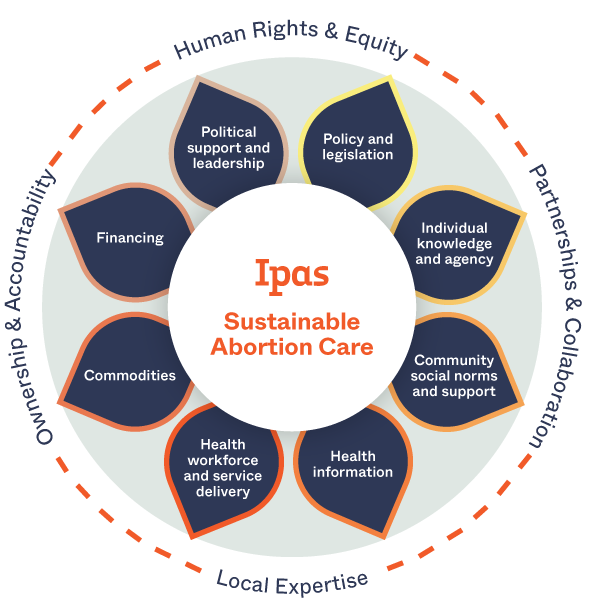This resource is for health professionals. If you’re seeking personal health information about abortion with pills, go here: www.ipas.org/abortionwithpills
Last updated: February 12, 2021
Recommendation:
- Less than 22-24 weeks gestation with one uterine scar: No changes to recommended regimens necessary.
- More than 22-24 weeks gestation with one uterine scar or 13-24 weeks gestation with more than one uterine scar: Consider decreasing the misoprostol dose with or without lengthening the misoprostol dosing interval. There is insufficient evidence to know if this impacts the risk of uterine rupture in these women.
Strength of recommendation: Weak
Quality of evidence: Very Low
Risk of uterine rupture with medical abortion
Uterine rupture has been reported during medical abortion at or after 13 weeks gestation in women with and without a uterine scar. The risk of uterine rupture for any woman undergoing a medical abortion at or after 13 weeks gestation is very rare, occurring in fewer than 1 in 1,000 women (Goyal, 2009). In a meta-analysis of 16 studies of 3,556 women undergoing medical abortion at or after 13 weeks gestation with combined or misoprostol-only regimens, three women suffered uterine rupture resulting in a rate of 0.28% with a previous cesarean section and 0.04% without (Goyal, 2009).
One single-center retrospective review of 279 women undergoing abortion between 14-26 weeks included 60 women with one and 26 women with more than one uterine scar (Küçükgöz Güleç et al., 2013). Women received misoprostol 200mcg vaginally every four hours; three had a uterine rupture. In another retrospective review of 263 women between 12-24 weeks undergoing misoprostol-only abortion, 48 had one and 29 had more than one scar; one rupture was observed in a woman with three prior cesarean sections who received a misoprostol regimen of 200mcg sublingually every three hours (Cetin et al., 2016). A third retrospective review included 231 women with one and 37 women with two prior cesarean deliveries, and used a regimen of 800mcg of misoprostol as a loading dose followed by 200mcg every two hours for three doses; no women experienced rupture (Torriente, Steinberg, & Joubert, 2017).
Regimen for women with a uterine scar
Due to the rarity of uterine rupture in women with a previous scar, no clear guidance can be obtained from the published literature (Borgatta & Kapp, 2011; Daponte, Nzewenga, Dimopoulos, & Guidozzi, 2006; Daskalakis et al., 2004; Dickinson, 2005; Morris et al., 2017).
Expert opinion supports:
- No change in medical abortion regimen for women with one uterine scar whose gestation is less than 22-24 weeks.
- After 22-24 weeks gestation with a single uterine scar or 13-24 weeks gestation with more than one uterine scar:
- Consider decreasing the dose of misoprostol with or without lengthening the dosing interval (Ho et al., 2007; Küçükgöz Güleç et al., 2013).
There is insufficient evidence to know if changing the dosing regimen will decrease the risk of uterine rupture.
References
Borgatta, L., & Kapp, N. (2011). Society of Family Planning Clinical Guideline 20111: Labor induction abortion in the second trimester. Contraception, 84(1), 4-18.
Cetin, C., Buyukkurt, S., Seydaoglu, G., Kahveci, B., Soysal, C., & Ozgunen, F. T. (2016). Comparison of two misoprostol regimens for mid-trimester pregnancy terminations after FIGO’s misoprostol dosage recommendation in 2012. The Journal of Maternal-Fetal & Neonatal Medicine, 29(8), 1314-1317.
Daponte, A., Nzewenga, G., Dimopoulos, K. D., & Guidozzi, F. (2006). The use of vaginal misoprostol for second-trimester pregnancy termination in women with previous single cesarean section. Contraception, 74(4), 324-327.
Daskalakis, G. J., Mesogitis, S. A., Papantoniou, N. E., Moulopoulos, G. G., Papapanagiotou, A. A., & Antsaklis, A. J. (2004). Misoprostol for second trimester pregnancy termination in women with prior caesarean section. BJOG: An International Journal of Obstetrics & Gynaecology, 112(1), 97-99.
Dickinson, J. E. (2005). Misoprostol for second-trimester pregnancy termination in women with a prior cesarean delivery. Obstetrics & Gynecology, 105(2), 352-356.
Goyal, V. (2009). Uterine rupture in second-trimester misoprostol-induced abortion after cesarean delivery: A systematic review. Obstetrics & Gynecology, 113(5), 1117-1123.
Ho, P. C., Blumenthal, P. D., Gemzell-Danielsson, K., Gómez Ponce de León, R., Mittal, S., & Tang, O. S. (2007). Misoprostol for the termination of pregnancy with a live fetus at 13 to 26 weeks. International Journal of Gynecology & Obstetrics, 99(2), 178-181.
Küçükgöz Güleç, Ü., Urunsak, I. F., Eser, E., Guzel, A. B., Ozgunen, F. T., Evruke, I. C., & Buyukkurt, S. (2013). Misoprostol for midtrimester termination of pregnancy in women with 1 or more prior cesarean deliveries. International Journal of Gynecology & Obstetrics, 120, 85-87.
Morris, J. L., Winikoff, B., Dabash, R., Weeks, A., Faundes, A., Gemzell-Danielsson, K., … Visser, G. H. A. (2017). FIGO’s updated recommendations for misoprostol used alone in gynecology and obstetrics. International Journal of Gynecology & Obstetrics, 138(3), 363-366.
Torriente, M. C., Steinberg, W. J., & Joubert, G. (2017). Misoprostol use for second-trimester termination of pregnancy among women with one or more previous cesarean deliveries. International Journal of Gynecology & Obstetrics, 138, 23-27.
